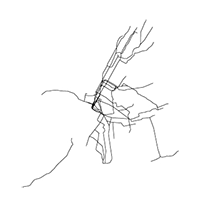Transfers: Part of Every Rail Transit System
About a third of Metrorail customers transfer between lines to complete their trip, and this is not too far off many of our peer transit agencies.
Everyone would prefer a “one-seat ride” (aka “transfer-free ride”) from origin to destination, but for many, transfers are a necessary part of commuting life. In fact, transfers may be even beneficial. Transfers are a part of nearly every large rail transit system with multiple lines, including Metro. As the chart below shows, 35% of Metrorail passengers change trains at some point during their journey, and that’s slightly higher – but not wildly different from – many of our peer transit systems in the U.S.
| (same scale for all images) | City | Customers Transferring * |
 |
New York City Subway |
 |
 |
WMATA Metrorail |
 |
 |
Boston MBTA, Subway |
 |
 |
Philadelphia, SEPTA(excl. Regional Rail) |
 |
 |
Chicago Transit Authority, Rail |
 |
| * Estimated rail-to-rail transfers per boarding. Data from NTD and agencies. Maps from Fake Is The New Real. | ||
The chart above compares annual unlinked passenger trips (counting passengers each time they board a vehicle), with internally reported boardings (counting passengers every time they go through turnstiles or faregates, regardless of how many vehicles they use during their trip) for each transit agency. This comparison gives a rough idea of how many customers transfer.
A transfer, particularly at crowded stations, can often “feel” like it takes longer than it actually does, and can lead to an inaccurate assessment of actual travel time. Recognizing this, transit planners usually count each minute spent transferring as two minutes – or more – in travel models.
Some observations from this chart:
- The number of transfers can largely be determined by the size and layout of the network. With more lines and more service, the rail system covers more area and connects more people, but the chances of your origin and destination being on the same line decreases, and more logical transfer points emerge.
- The number of transfers is also determined by how frequent the service is. As any rider knows, transferring can be less convenient when trains aren’t running as frequently.
- Interlining trains can provide more one-seat-rides, but at the cost of suboptimal frequencies. In fact, transfers can sometimes be more efficient – and faster for you – than a no-transfer rail system.
- Urban form also influences transfers. In Chicago, for example, all lines serve the downtown Loop area, where employment is intensely concentrated.
One word about the data: measuring how many rail-to-rail transfers customers make in U.S. rail transit systems is not a perfect science. Unless you “tap out” of the rail system when you exit, the transit system must estimate where you exited – and hence, whether you had to transfer or not. And even with exit information here at Metro, we still have to estimate where more than one route is available. Fortunately, the Federal Transit Administration issues specific instructions to all transit agencies for how to estimate rail-to-rail transfers using statistical sampling, so this gives consistent way to compare transfer estimates across different systems.
Note: I left out BART from this chart, since information on transfers between BART and SFMTA along Market St. was not immediately available.


Metro is a hub and spoke system so it makes sense that many people need to transfer from line to line. When I lived there I didn’t really see any problem with rail to rail transfers, other than on weekends when the wait could be endless. The proposed circle line may reduce the number of transfers, but only for folks riding within the circle area. It still doesn’t account for the core-to-suburb or suburb-to-suburb commutes.
In the Bay Area, most BART lines run from the East Bay through downtown SF and points south. Then again, BART acts more like a commuter rail system, than a metro mass transit system, like NYC. There are only a handful of transfer points (19th Ave/Oakland, MacArthur, Bayfair and Balboa Park) among the 5 lines and many of these are only relevant on weekends when service is reduced from 5 lines to 3.
I concur with Mark. A real issue with transfers is the time between train A and B. But Metro’s 35%, whether ‘good’ or ‘bad’ as a percentage, is difficult to compare to other systems. NYC is a true subway, Boston is a bit of a mix, DC is really a commuter rail metro, etc. In each situation a transfer means more or less than in another system.
Here’s a little graphic I whipped up to illustrate (very roughly) the geometries of New York and DC and the subway and metro. Doesn’t really “tell us” anything, but kinda neat to look at. https://scontent-a-iad.xx.fbcdn.net/hphotos-prn1/t1/1620921_422351447910445_1805614900_n.jpg
I also concur… it depends on the line, time of day, and day of week, of course, but in New York a transfer is often less than a 5 minute wait, and very often only a minute or two. AND when you actually get off that transfer has gotten you a lot closer to your final destination than a Metro stop is likely to do.
A network that prioritizes coverage over one-seat rides will far better serve riders. E.g., you can serve twice as many people by requiring a connection.
BUT this is only a valid tradeoff when in exchange for requiring a transfer, the other lines run more frequent service. This is one of WMATA’s worst traits. Your headways are abysmal and the prospect of spending 40+ minutes just on waiting for a train to arrive is enough to deter the heartiest of transit riders.
Fix that and you might start winning people back.